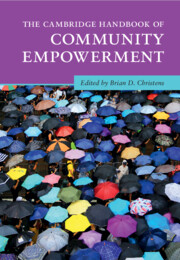Book contents
- The Cambridge Handbook of Community Empowerment
- Cambridge Handbooks in Psychology
- The Cambridge Handbook of Community Empowerment
- Copyright page
- Contents
- Figures
- Tables
- Contributors
- Building Community Power
- Part I Organizing and Activism
- Part II Participatory Governance
- Part III Civil Society and Coalitions
- 11 Community Leadership Development
- 12 Community Coalitions and Empowerment
- 13 Youth-Infused Community Coalitions
- 14 Neighborhood Associations and Community Change
- 15 State-Led Community (Dis)empowerment in China
- Part IV Enterprise
- Part V Participatory and Community Arts
- Part VI Education and Engaged Research
- Contributor Details
- Index
- References
12 - Community Coalitions and Empowerment
from Part III - Civil Society and Coalitions
Published online by Cambridge University Press: 18 April 2024
- The Cambridge Handbook of Community Empowerment
- Cambridge Handbooks in Psychology
- The Cambridge Handbook of Community Empowerment
- Copyright page
- Contents
- Figures
- Tables
- Contributors
- Building Community Power
- Part I Organizing and Activism
- Part II Participatory Governance
- Part III Civil Society and Coalitions
- 11 Community Leadership Development
- 12 Community Coalitions and Empowerment
- 13 Youth-Infused Community Coalitions
- 14 Neighborhood Associations and Community Change
- 15 State-Led Community (Dis)empowerment in China
- Part IV Enterprise
- Part V Participatory and Community Arts
- Part VI Education and Engaged Research
- Contributor Details
- Index
- References
Summary
Community coalitions promote empowerment by providing pathways for residents and organizations to gain and apply new skills, grow in leadership, and play an active role in calling for and creating community change. Coalitions create synergy through strategic pooling of diverse and complementary perspectives, connections, and resources. This chapter provides a brief overview of coalitions and how they operate as a community change mechanism by providing a structure to create changes in policies, systems, and environments. We present a case study of the California Healthy Cities and Communities initiative in which leaders in twenty communities with underserved or vulnerable populations were empowered to address environmental and structural determinants of community well-being. Next, we review the literature on how coalitions have been studied as a mechanism for community empowerment across disciplines and levels of empowerment. We conclude with recommendations for future research, including a greater focus on equity and understanding community change processes.
Keywords
- Type
- Chapter
- Information
- The Cambridge Handbook of Community Empowerment , pp. 313 - 336Publisher: Cambridge University PressPrint publication year: 2024



